Core mortars: forgotten forever or not?
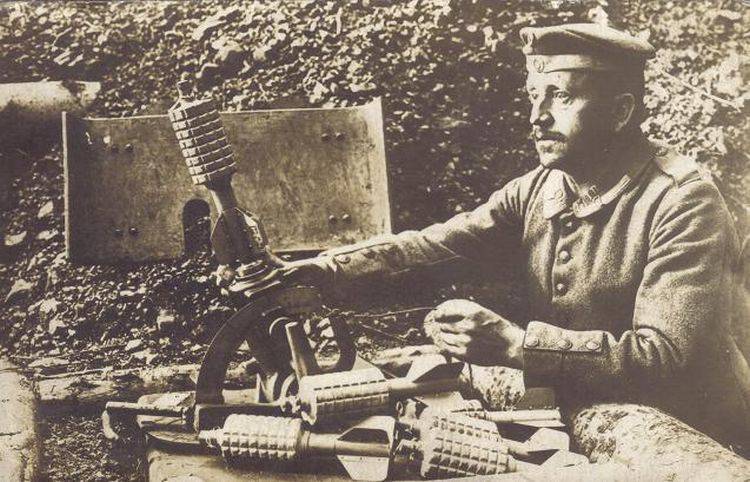
"Grenade mortar" in action.
They started with the German mortar Granatenwerfer 16, developed by an Austrian priest in 1915, but first of all in the German army. Arranged this weapon was extremely simple: a trunk with a carrying handle, a base plate with a protractor, a barrel clamp and a firing mechanism. The barrel was bottle-shaped in order to better enter the hollow tail of the grenade. The firing mechanism of the shock type was located in the trunk and descended by “pulling the string”. Elevation angles ranged from 45 to 85 degrees. For aiming at the target, a handle was used on the barrel, after which the barrel was fixed with a special clamp. The Germans themselves called him a grenade launcher (a grenade thrower), but the name “grenade mortar” would be quite appropriate for him.
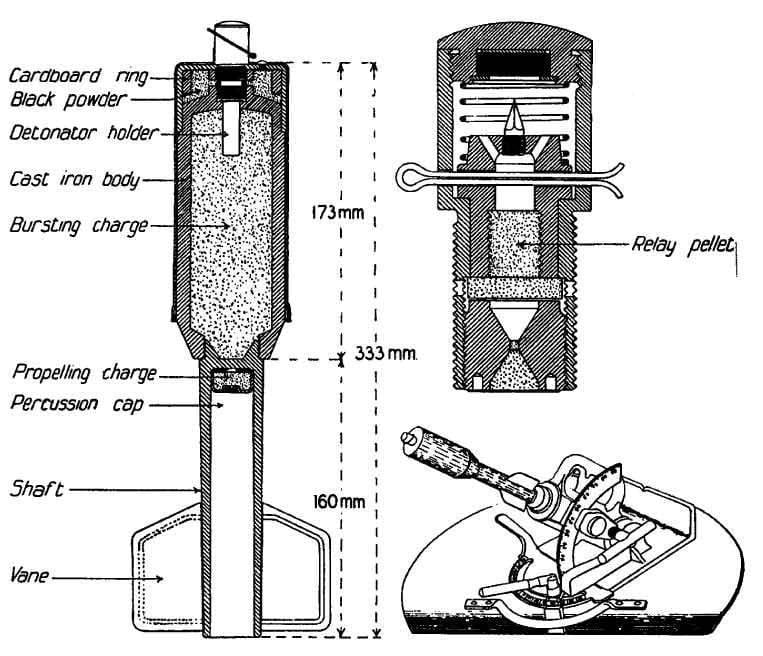
Mina to the German "grenade mortar."
Shooting from it was carried out with a grenade with a notched shell, which gave the same fragments at break in shape and weight. The inertial fuse had a high sensitivity, so that when it hit the ground, the grenade did not have time to go deeper and all the fragments flew in different directions. In this case, in the nose of the grenade there was a special charge of black powder, so that the gap of the grenade could be seen from afar! The longest firing range was achieved at an elevation angle of 45 degrees and was (depending on the type of mine) from 255 meters to 300 meters. At an angle of 85 degrees, the distance was minimal - 50 meters, and you had to pay attention to the wind, so that they did not put a grenade on your head! Although the weight of the system turned out to be about 41 kg, on the battlefield it could easily move the crew, which consisted of only two people and even carry ammunition behind it, and even one soldier if necessary.
Mortar Granatenwerfer 16 arr. 1916
Interestingly, the fire was fired from the base platform, into which a screw located on the mortar plate was screwed. It turned out that the mortar rotated in all directions along with the stove on this basis, that is, it could hit targets 360 degrees! German soldiers liked this weapon. Sit in a trench and “bullet” mine mine by mine! It is not surprising that mines were issued to him in large quantities, and his mines were used even in aviationwhere they were used as light bombs. But the main feature of it, we emphasize, was that a mine or a grenade was put on the barrel, and did not interfere in it.
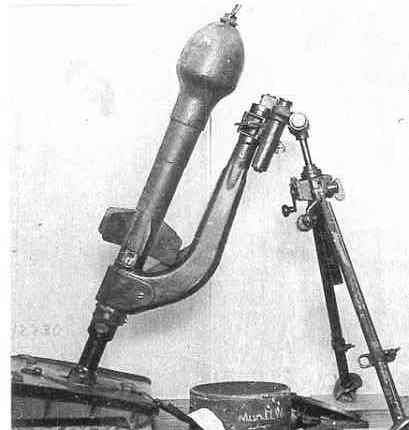
German 8,9 / 20, see the rod mortar: photo
Years passed, the Stokes-Brand mortars settled in the German army, which was already the Wehrmacht, but the Germans were armed with 8,9 / 20, see the core mortar. The mortar caliber (bar diameter) was 89 mm. Weight 93 kg. The rate of fire was 8 - 10 shots per minute, that is, quite well for a weapon that fired mines weighing 21,27 kg (!) At a distance of about 700 m, while the weight of the explosive that it delivered to the enemy was equal to 7 kg, that is, it was more the weight of the actual projectile Soviet 76,2-mm gun! With the caliber of the warhead, this mortar was used to destroy the enemy’s long-term gun emplacements, his infantry, to install smoke screens, even to destroy minefields.
Well, it consisted of the following parts: a smooth guide rod in (a simple steel pipe), which had a breech with ball support (in addition, a bracket was attached to it), a support plate and an ordinary bipod. Simple, isn't it? But the main thing - the caliber of the warhead - 200 mm. But already for the Soviet caliber 160-mm mortar needed and complex loading system, and the wheel course, that is, it was a really powerful tool, that's just in the trench for its melee was not put! Meanwhile, along with the 89 / 200-mm rod mortar, the Germans also used a rod mortar that fired 380-mm high-explosive and smoke mines. The weight of a mine of this caliber was equal to 150 kg, and the weight of the explosive charge - 50 kg!
Diagram of the 29-mm rod "Blaker bombers".
Well, now it should be said about the British, who at the beginning of World War II were very unlucky. In Dunkirk, they threw so many weapons and military equipment that they simply had nothing to defend the British Isles. Everybody knows history that this is exactly the case, for example, the “dream of a plumber” appeared - the “Stan” submachine gun. However, the need of the mother prompted the British military to adopt even more unusual constructions and, in particular, the “Baker’s bombardment”, and in fact another, already British, type of mortar.
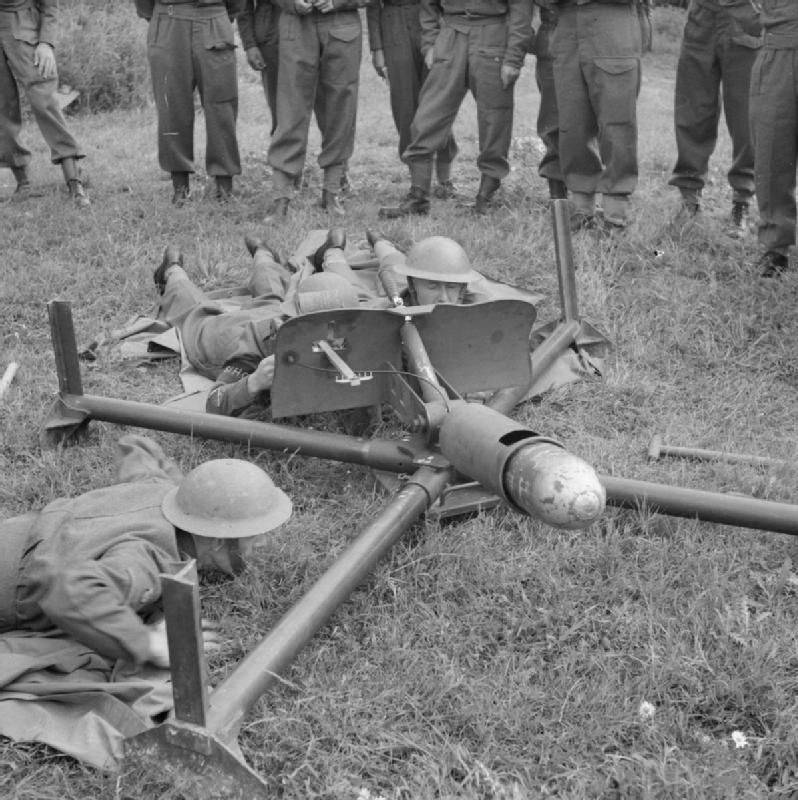
Tests "bombardy".
It was so that Lieutenant Colonel Stuart Blaker became interested in rod mortars, hoping to create a model more efficient than the Stokes system. But then Dunkirk arrived in time, the army lacked anti-tank guns, of which 840 were left in France and only 167 were in England. And the shells to them were so small that even for training purposes they were forbidden to shoot.
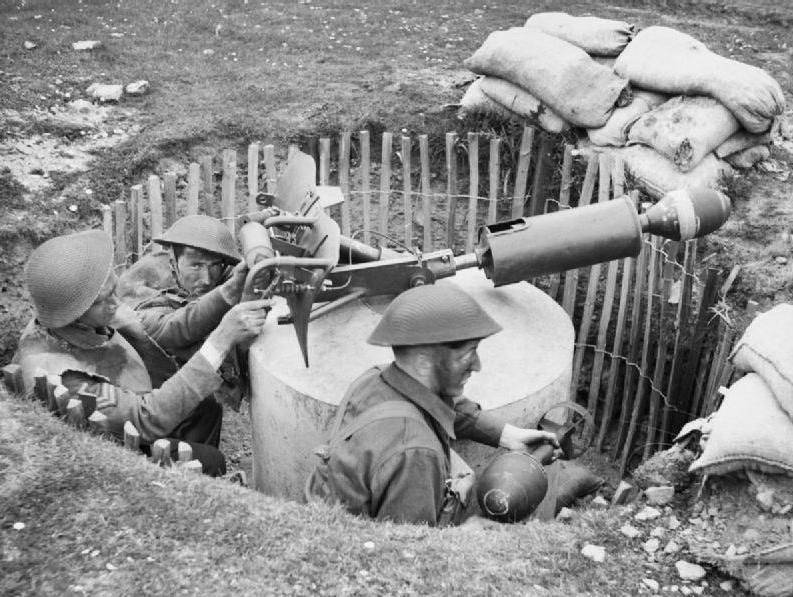
Calculation of "bombards" in the "mortar pit" is preparing to fire.
So, Blaker thought, and even offered his design to the Department of Armaments as an anti-tank weapon, promising efficiency no less than that of 42-mm guns! Many servicemen expressed doubts about the fact that this is all the way it will be and “this” in general should be adopted. However, on August 18, the Prime Minister, Winston Churchill, took part in the tests of the new weapon himself, and he ... liked it! He stated that it would be used as a temporary replacement for anti-tank guns and would go into service for the militia. If we consider that the militia of English citizens and farmers at this time was generally armed with hunting rifles (in the funny French - and not completely tolerant comedy "Babette goes to war" this moment was beaten up very well), then such a serious weapon immediately raised his credibility and sense of his own significance. That is, his role as a “weapon of PR” outweighed all other considerations!
However, what to say: outwardly, the bombard looked very impressive. The fact is that Blaker, although he created it as a rod mortar, for some reason still retained on it ... an outer barrel-casing, which did not play any special role, but gave it solidity. Inside is the actual rod with a diameter of 29-mm, on which the mine’s tail was put on. Cross-shaped legs-supports made it possible to fix the bombard on the ground, and the shield protected the calculation from bullets and fragments. The weight of the barrel and the mechanism was 50 kg, the machine weighed 100! The bomb weighed 20 kg and could be sightingly released into the target 100 yards away (91 m). There were two types of ammunition: high-explosive and incendiary. The rate of fire reached 5-8 shots per minute, but actually it was even less.
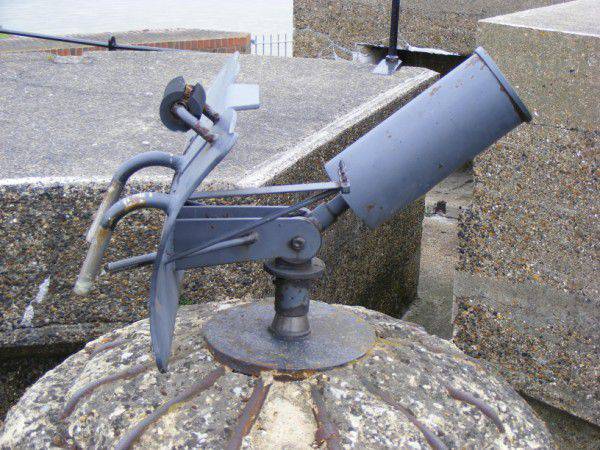
"Bombard" on a concrete base.
They decided to use them as ... stationary, positional guns! For this, across the coast of Britain, they began to dig “mortar pits” - “mortar pits” with the peculiarity that in the center of each such “pit” a concrete or foundation was installed, on which only the barrel of “Blaker bombers”, loosely attached to all 360 degrees. In such a quality, it was a good weapon with which you could train regularly and increase combat readiness in case of an invasion!
As a weapon of the “battlefield” of the “bombardment,” as they say, “did not go.” Firstly, she bounced high when shooting and strove to break the neck of the gunner. Secondly, these "bombers" followed from ambushes. However, as one sergeant said, “I don’t smile every time I change my pants after I’m waiting for German tank I’ll have to lie in the roadside ditch or in the bushes, and besides, let him go 50 meters! ” True, it was noted that if a bomb from a mortar fell into a tank, then it was guaranteed to disable it. There was a very large explosive charge in it. But ... but a tight fuse that did not work!
However, the Blaker bombers were produced ... 18 919 pieces, and about 250 the bombardment was delivered to 1941 - 1942's. in the USSR under the Lend-Lease program. As a result, only one experience with the use of such bombs became positive, which ultimately led to the creation of a truly effective anti-submarine hedgehog bombs.
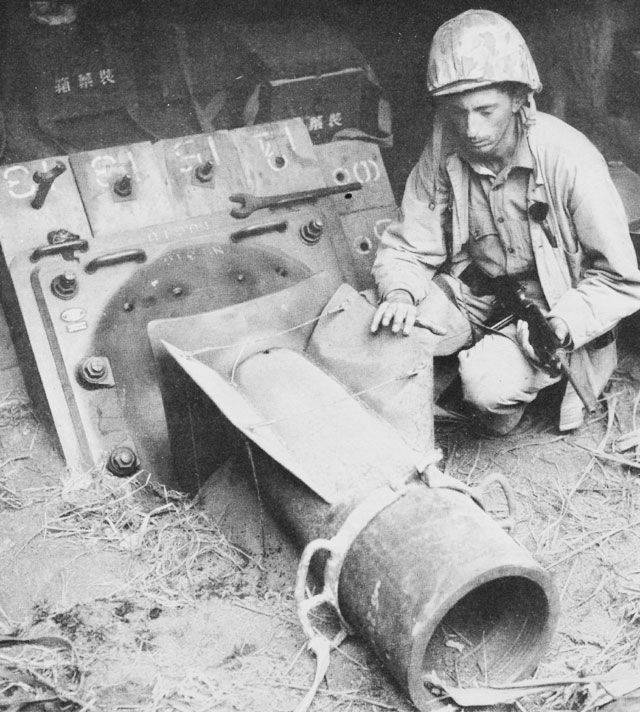
US Marine near the mortar "Type 98" on Iwo Jima.
However, even the German 380-mm mines slightly pale before the Japanese 320-mm mines to the rod mortars of their own design, because their weight reached 306 kg! The mortar had the designation "Type 98" and was a rectangular support of bars, from which the launch tube protruded. And ... everything! An even heavier 400-mm mortar had a similar design. For arranging the position, they dug a pit with sloping walls, and one of them was placed on this support, and a mine was put on a rod sticking out of it. Support enough for 5-6 shots, after which the support came into disrepair. The shot was made by electric shock. It is clear that about any rate of fire and the speech did not go, but the weapon was effective. The fact is that the Japanese put such mortars against American landings on the Pacific Islands. Somewhere 12-24 was delivered on Iwo Jima Island, 24 on Batan Island, and they were also on Tarawa and Okinawa. They shot at the water's edge, a place where the landing technique always slows down its course and the paratroopers leave it. Mine explosions left craters in 2,4 m in depth and 4.6 m in diameter and exerted an extremely strong demoralizing effect on the US marines. On Iwo Jima, 12 of such mortars were installed in the mouths of caves and therefore inaccessible to American bombs, while they themselves simultaneously fired their huge shells at the water's edge.
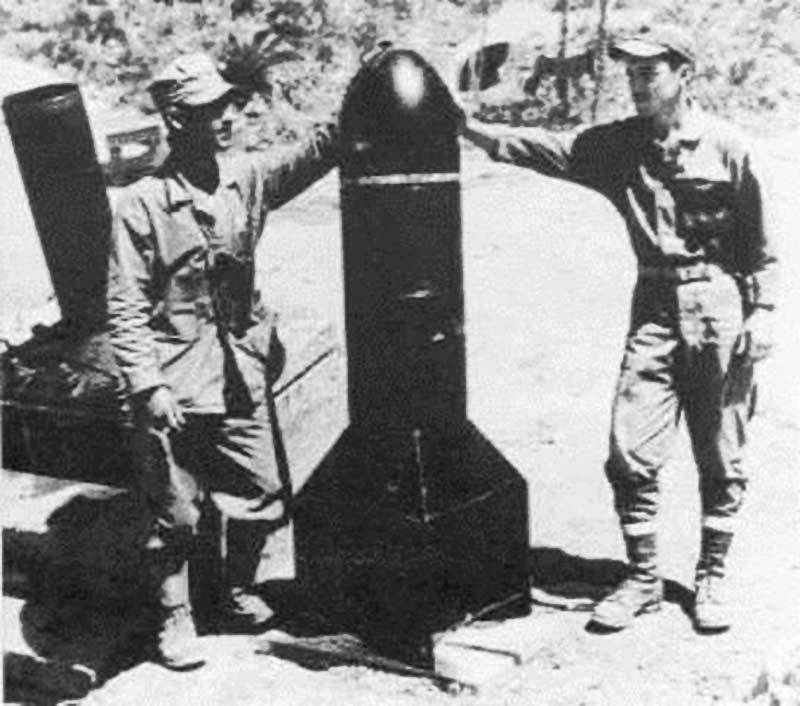
320-mm mine to the Japanese rod mortar.
It should be noted that in modern conditions it is the core mortars that represent the ideal weapon of the guerrilla war, since they are very easy to produce in artisanal conditions. Calibers they can be very different, they can be placed in the car, in trenches, mask in the pits. All this, by the way, was appreciated by the Italians who adopted the AR / AV700 three-barrel rocket launcher, firing conventional rifle grenades that are worn on launch rods, similar to rifle barrels. The shot is made as follows: inside the rod passes a channel through which the bullet of an ordinary rifle cartridge 5,56 or 7,62-mm moves, depending on the modification. Inside the grenade a bullet hits the primer, which ignites the propellant charge and the jet engine. In flight, a grenade stabilizes the plumage. Due to this, the firing range reaches 700 m.
Italian rod grenade launcher AR / AV700.
You can shoot in one gulp or one at a time, with 6-7 rate of fire per minute. Penetration of a cumulative grenade - 120 mm. The length of the stem-barrel 300 mm, the weight of the installation - 11 kg, grenades 920 g, its charge - 460 g. It is clear that by this principle you can make 6,8, 12-t and more chargers again in the car, well rifle grenades in warehouses today are also missing.
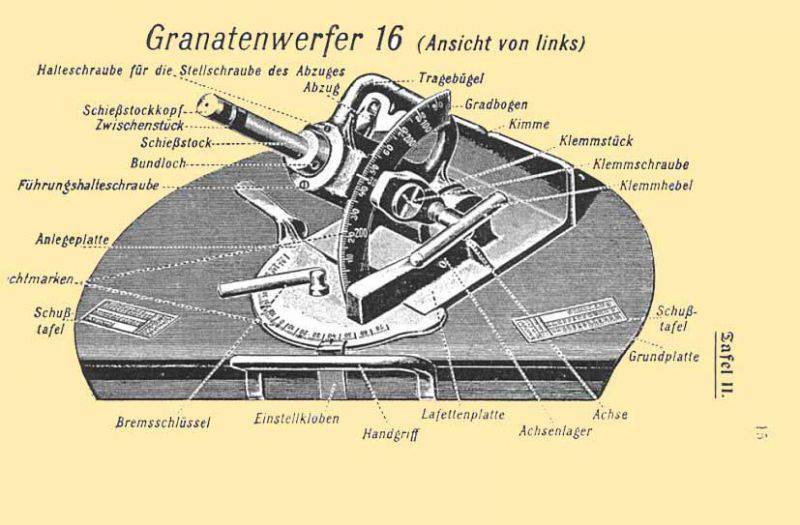
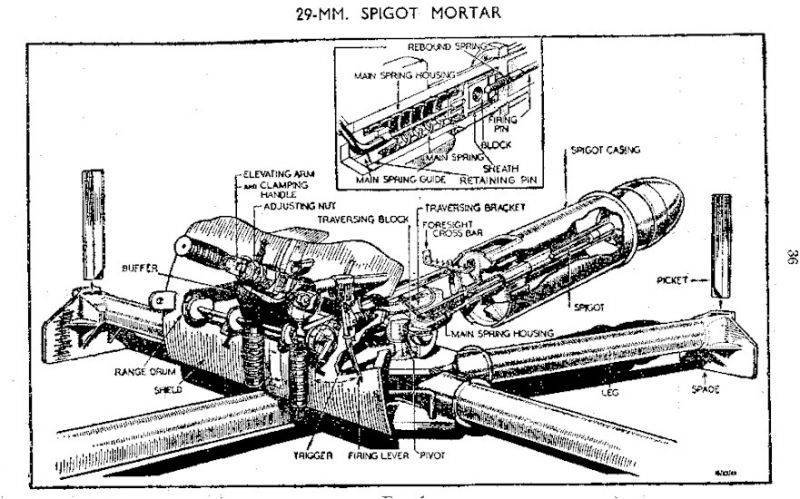
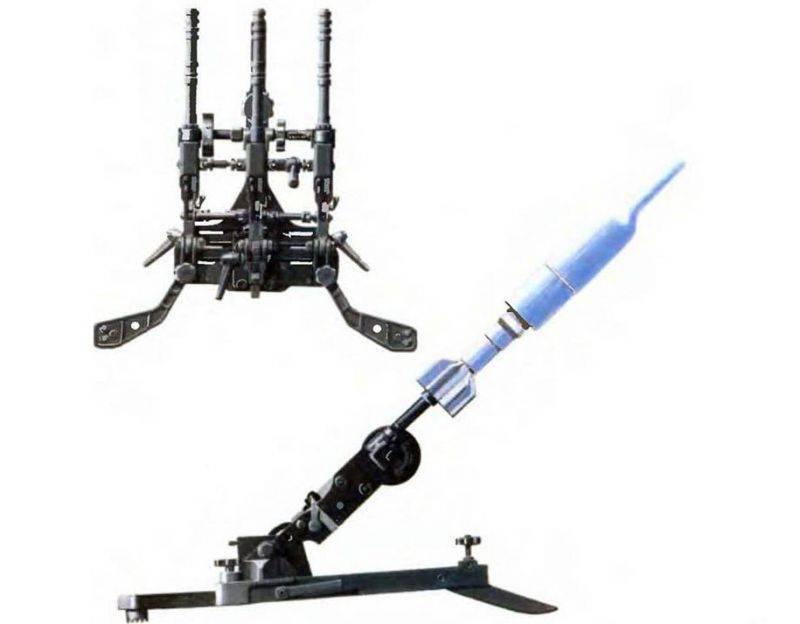
Information